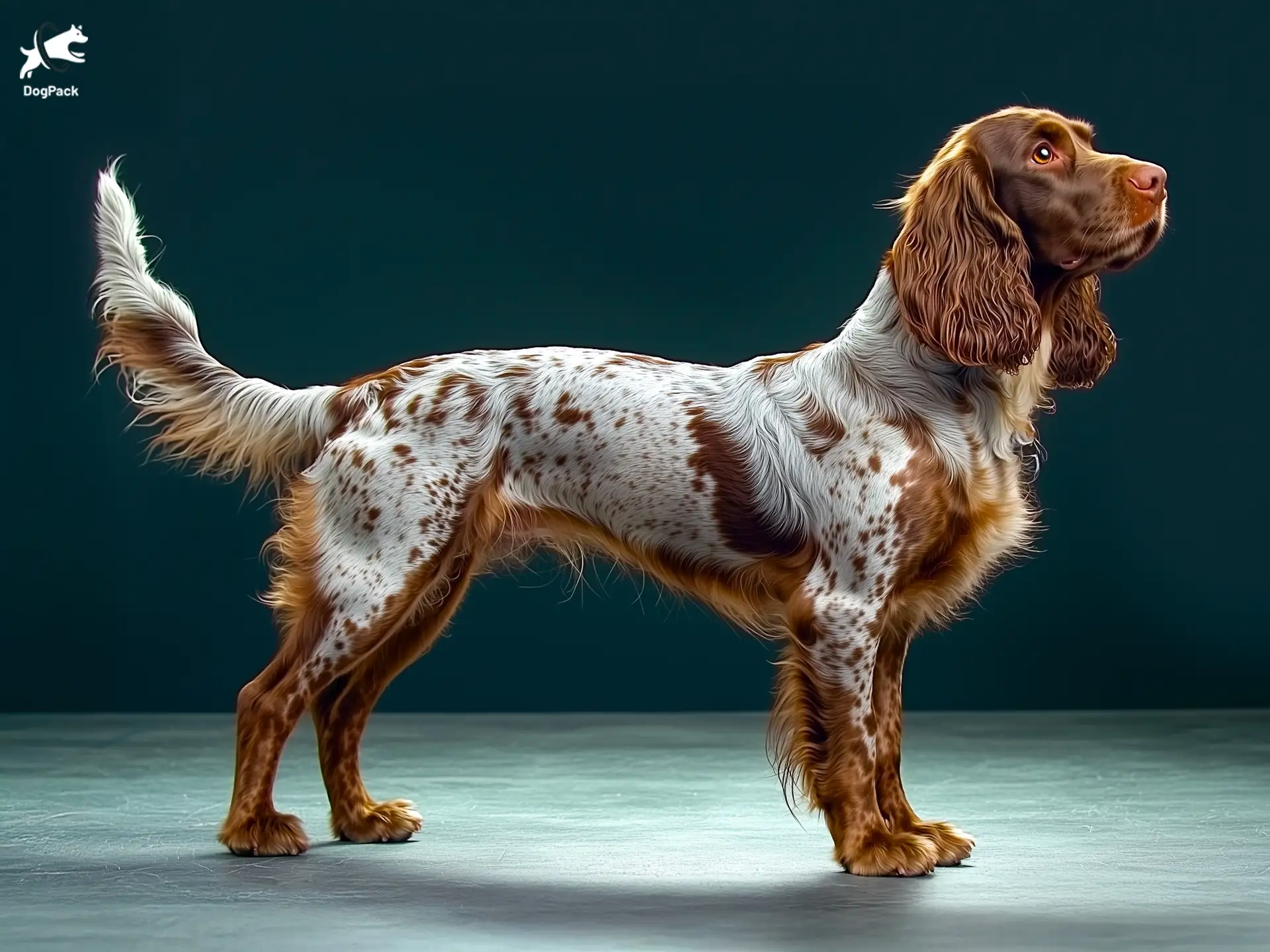Picardy Spaniel Dog Breed Info & Overview
The Picardy Spaniel is a graceful and good-natured breed prized for its versatility and calm demeanor. Originating in France, it was bred for hunting in marshy terrain but is just as content by your side at home. With its soft expression, elegant coat, and steady temperament, the Picardy Spaniel makes a wonderful companion for active families and outdoor enthusiasts alike.
Characteristics
Pictures
Breed History
This spaniel’s roots can be traced back to the Picardy region of northern France, where it was bred to flush and retrieve game across marshy grounds. Hunters prized its exceptional nose and unflinching spirit. Some enthusiasts believe the breed’s lineage stretches to ancient French water spaniels, though precise records are scarce. Over centuries, the Picardy Spaniel refined its hunting prowess in damp, challenging environments.
Centuries ago, when French nobility indulged in extensive hunting expeditions, these dogs were a welcome companion in duck blinds and sprawling fields. Their calm demeanor during downtime made them a household favorite, yet they’d switch on laser-like focus once the hunt began. Historians note that the breed’s reputation remained largely regional, thereby maintaining its somewhat exclusive status for many generations.
Interestingly, the name “Épagneul Picard” reflects the breed’s intimate connection to its home province. Early fanciers ensured that only the most proficient gundogs were bred, favoring the robust coats and endurance needed for Picardy’s rugged terrain. Over time, small clubs dedicated to the Picardy Spaniel sprang up, helping preserve its heritage despite changing hunting trends. Today, it remains a hidden gem among sporting dogs.
Temperament, Personality
Affectionate yet independent, this spaniel is often described as having a friendly face and a curious soul. Their eagerness to please shows in how they greet loved ones: tail wagging, eyes shining. Nevertheless, they maintain a reserved streak around new faces, so gentle introductions are key. Owners praise their sense of humor, as they’re known to carry favorite toys around or flop into hilarious sleeping positions.
When living with children, these dogs can be remarkably patient, matching a child’s enthusiasm with calm tolerance. They’ll also keep an eye on younger family members, almost like a watchful older sibling. However, it’s essential to teach kids proper canine etiquette. Despite their sweet temperament, the Picardy Spaniel appreciates respectful handling and personal space—especially during meal times or rest periods.
Early socialization helps this breed adapt to multi-pet households. A Picardy Spaniel may initially be uncertain about feline friends or smaller critters, but with gradual, positive introductions, they often coexist peacefully. They thrive on social connections but value quiet moments, too. This balance of extrovert meets introvert makes them adaptable companions for families who enjoy active days yet welcome a cozy wind-down each evening.
Physical Characteristics
One glance at this dog’s coat, and you’ll see shades of gray, brown, and mottled white that create a gorgeous speckled pattern. Their ears hang long and low, framing a gentle expression that hints at their amiable nature. Build-wise, they carry a sturdy, athletic frame, perfect for powering through fields or brush without wearing out.
Most Picardy Spaniels stand solidly on well-boned legs, supporting a body designed for endurance rather than sprint speed. Their chest is moderately deep, offering plenty of lung capacity for a day’s worth of romping. The breed’s tail typically maintains a natural curve, subtly swaying from side to side in that joyful wag they’re famous for.
Their medium-length coat offers protection from the elements, which can be especially handy during water retrieves. Feathering is noticeable on the legs, ears, and tail, adding to their overall grace. While not as flashy as some other sporting breeds, there’s a certain understated elegance in a Picardy Spaniel’s physique. That quiet regal look suits their mild-mannered but determined personality perfectly.
Health Issues
Most are robust, but like many purebreds, they’re not entirely free of health concerns. Hip dysplasia can appear, leading to joint discomfort or limited mobility if untreated. Regular vet visits, plus screening of parents, can significantly reduce the chances of acquiring this issue. Early detection of any skeletal irregularities makes a world of difference in managing potential pain later in life.
Ear infections may develop, especially given those gorgeous drooping ears that can trap moisture. Owners should clean and check them routinely to prevent bacterial overgrowth. Another possible concern is allergies, which can manifest as itchy skin or ear irritation. A veterinarian may recommend dietary changes or topical treatments to address any persistent flare-ups.
Responsible breeders will often run tests on litters to catch hereditary eye conditions. While these dogs typically have bright, healthy eyes, vigilance never hurts. A balanced lifestyle, combining proper nutrition, regular exercise, and mental stimulation, also fortifies overall well-being. When in doubt, consult reputable sources or peer-reviewed journals for the most current health recommendations specific to this breed.
Grooming Needs
The Picardy Spaniel’s coat is certainly low-maintenance compared to some fuller-feathered gundogs, but it does require consistent brushing. A thorough session once or twice a week keeps shedding under control and coat oils distributed. Brushing also prevents matting around the ears, chest, and tail, especially if your pup has spent the day diving through tall grass or damp fields.
Because their feathering can pick up debris, it’s wise to do a quick post-walk check—particularly around legs and under the belly. Trimming stray hairs between the paw pads helps maintain traction and keeps mud from building up. While professional grooming isn’t mandatory, some owners prefer a tidy trim, especially if the dog’s comfort or hygiene is compromised by excessive hair.
Bathing can be done every couple of months or as needed, especially if your four-legged friend has had a muddy adventure. A gentle dog shampoo usually works well, but always ensure a complete rinse to avoid residue. Nails grow at a moderate pace, so check them monthly, and trim if they start clicking on floors. This straightforward routine keeps them looking sleek and feeling fresh.
Exercise Requirements
Expect to set aside at least an hour or two each day to satisfy this dog’s energy. They’re happiest when engaged in activities like long hikes, field work, or even advanced obedience challenges. Some owners joke about the “Picardy pounce,” where they’ll leap excitedly into the nearest patch of tall grass to flush out birds, real or imaginary. It’s all part of the fun!
Due to their heritage as a hunting spaniel, they excel in retrieving games or obstacle courses. If you don’t hunt, not to worry: agility, scent work, or even fetch in a large yard can keep them physically and mentally sharp. A bored Picardy might become destructive or overly vocal, so varied, engaging tasks are essential to channel their natural drive.
Water play often ranks high on their list of joys. If you’re near lakes or have access to safe swimming spots, an afternoon splash is the perfect exercise. Just keep an eye on them, as strong swimmers can get a bit too enthusiastic. If you’re curious about other large dog breeds that require ample exercise, the Picardy Spaniel stands out for its blend of stamina and adaptability.
Training Tips
This breed is intelligent yet sometimes free-spirited, so positive reinforcement stands out as the best strategy. Reward them with treats, praise, or a quick game of fetch, and you’ll see real progress. They can be slow to warm up to novel environments, so gentle exposure—like exploring different parks—helps them develop confidence without feeling overwhelmed or pressured.
Consistency matters. One amusing quirk is how quickly they learn certain commands but conveniently “forget” if there’s something more interesting going on. Keep sessions fun and short, and avoid heavy-handed tactics—they’ll shut down if training becomes too forceful. Patience is your friend; these dogs typically aim to please, so a calm, steady approach typically yields enthusiastic cooperation from a Picardy Spaniel.
If you notice any stubborn streak, it’s usually just them testing boundaries. Offer variety in training exercises to stimulate their mind. Introducing puzzle toys or advanced retrieves can prevent them from getting bored. Also, rope in the entire family to maintain consistent rules and commands. Cross-reference other sporting dog breeds for tips, but remember that each breed has its own nuanced style of learning.
Nutrition, Diet
Given their active lifestyle, Picardy Spaniels often benefit from a protein-rich diet that supports muscle tone and sustained energy. Meals containing real meats (such as duck or game bird) can align well with their hunting heritage, though high-quality chicken or turkey also works. A moderate dose of healthy fats from sources like fish oil can help maintain that shiny, speckled coat.
Adult Picardy Spaniels typically thrive on two daily meals, totaling around 2.5 to 3 cups of premium kibble or its wet food equivalent. Puppies, however, might need three smaller meals to sustain growth without overloading their stomachs. It’s wise to factor in treats or training rewards when calculating daily intake. Balancing calories helps prevent unnecessary weight gain, which can strain their joints.
Because these dogs are so enthusiastic about exercise, consider diets formulated for “active” or “sporting” breeds. Such recipes often provide extra energy without risking nutritional imbalances. Monitor for signs of food sensitivities—excessive itching or digestive upset could mean a switch is in order. Whenever possible, consult with a vet specialized in sporting dogs, as nutritional fine-tuning can significantly impact a Picardy Spaniel’s overall performance and well-being.
Adoption, Breeders
If you’re seeking a Picardy Spaniel, it’s crucial to connect with breeders who prioritize temperament and health tests. Look for those who conduct hip and eye checks, and can provide detailed lineage information. Because of their rarity outside France, importing from recognized European breeders might be an option—just be sure you’re equipped to handle the logistics and associated costs.
Reputable rescues sometimes have older Picardy Spaniels that need rehoming. You can monitor local breed-specific rescue groups or global adoption portals. Because they’re relatively scarce, patience is vital—there may be fewer dogs available at any given time. Nevertheless, adopting can be immensely rewarding, especially for those who appreciate a mature dog’s calmer disposition and pre-existing training.
Check out the NAPSA (North American Picardy Spaniel Alliance) or Club de l’Épagneul Picard for French-based enthusiasts. These websites often feature detailed breed info and contact details for clubs or fosters. Remember, verifying credibility is key: genuine resources will happily share health records, references, and community ties. The goal is to ensure every Picardy Spaniel finds a loving, prepared home.
Family Pet?
The gentle nature of a Picardy often translates well to family living. They’re typically fond of joining group activities—from picnics in the park to backyard games of fetch. Their patient streak means they can handle a bit of harmless chaos, so they often gel with boisterous households. Still, it’s essential to provide calm spots where they can retreat if stimulation becomes overwhelming.
With children, these dogs can be comforting companions, ever-watchful yet not overly protective. They’ll happily curl up next to a kid reading a book or trot alongside a bicycle ride around the neighborhood. Most conflicts arise if young ones poke or pull at them, so supervise interactions and teach respectful handling. A dog that feels safe is more likely to form lifelong bonds.
In multi-pet homes, consistent introductions pave the way for harmony. If everyone has their own space, daily routines become second nature. Because they’re so people-oriented, a Picardy Spaniel might try to join every family activity, whether that’s making breakfast or chilling on the couch.
Right For You?
Ask yourself: Are you an outdoor enthusiast with the time and space for a high-energy dog? If so, the Picardy Spaniel could be a match made in heaven. They bond deeply with their families, so consistent attention is key. Ideally, you’ll offer mental stimulation, too—like advanced training tasks or puzzle feeders—because they thrive on meaningful interaction.
If your schedule barely allows for 15-minute walks, you might want to reconsider. This breed loves being active, so small living spaces or sedentary lifestyles can lead to frustration (and maybe chewed shoes!). However, if you can meet their needs, they repay you tenfold with unwavering loyalty, comedic antics, and genuine companionship. Essentially, the Picardy Spaniel suits folks who view an energetic canine as a cherished teammate.
Before diving in, research thoroughly. Consult owners’ forums, connect with breeders or rescue groups, and maybe even meet a Picardy in person if possible. The more you learn, the clearer your decision becomes. If you’ve got the energy, space, and big heart they deserve, this gentle yet spirited dog will thrive by your side, bringing countless wagging-tail moments into your daily routine.
Conclusion
This lesser-known sporting dog offers the perfect blend of warmth and drive. The Picardy Spaniel is loyal to its people, excels in the field, and adores a comfy couch at day’s end. As long as you’re ready for the moderate grooming, health checks, and energetic outings, you’ll find a steadfast companion who fills your life with laughter, devotion, and a dash of French flair.
FAQs
-
What type of game is the Picardy Spaniel best known for hunting?
The Picardy Spaniel is especially prized for upland bird hunting, including pheasants, woodcock, and partridge. Its ability to work in dense cover and wet environments makes it a versatile gundog for both marshlands and forests.
-
Is the Picardy Spaniel well-suited for waterfowl retrieval?
Yes, the Picardy Spaniel has a natural affinity for water and is frequently used for waterfowl retrieval. Its thick coat and strong swimming ability allow it to perform well in cold, wet hunting conditions.
-
How does the Picardy Spaniel behave in multi-dog households?
The Picardy Spaniel is generally peaceful and tolerant around other dogs, especially if raised with them. Its laid-back temperament and cooperative nature make it a good fit for homes with multiple pets or working teams.
-
Is the Picardy Spaniel recognized in North America?
While rare, the Picardy Spaniel is slowly gaining interest in North America. It is recognized by the United Kennel Club (UKC) and various French breed clubs but remains uncommon outside its native France.
-
What sets the Picardy Spaniel apart from the Blue Picardy Spaniel?
The Picardy Spaniel has a liver-colored coat with ticking, while the Blue Picardy Spaniel features a bluish-gray hue due to black and white intermixing. Though closely related, they are separate breeds with distinct coat patterns and lineage.
Breed Ratings
The Picardy Spaniel is quick-witted with a touch of stubbornness, responding well to positive, patient training sessions.
This breed loves interactive fun, from fetching tennis balls to romping around the backyard, especially with family members.
Expect a high-octane companion that thrives on daily exercise, outdoor adventures, and challenging mental tasks.
Moderate shedding occurs year-round, though regular brushing helps keep hair under control.
Bred for hunting, they have a strong drive and may chase smaller animals if not properly trained or supervised.
Weekly brushing is necessary to manage feathers and tangles, but no elaborate grooming is required.
Intelligent and eager to please, though occasional independent streaks require consistent, rewarding techniques.
They prefer company and can grow anxious if left solo for long stretches without engagement.
Generally moderate; they’ll alert when necessary but aren’t prone to constant noise unless bored.
Drool is minimal, often limited to mealtime or after a vigorous drink of water.
With proper socialization, they get along well with other canines, enjoying both play and companionship.
Generally sturdy, yet susceptible to ear infections and hip issues, so regular vet checkups are key.













